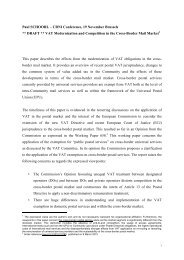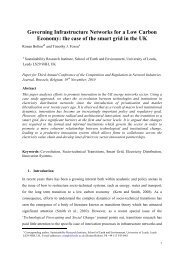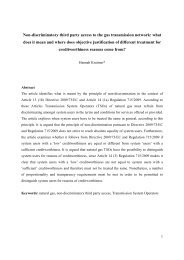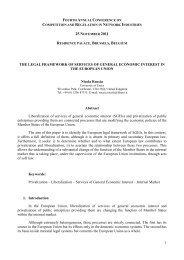Regulatory Incentives for Investments in Electricity Networks - CRNI ...
Regulatory Incentives for Investments in Electricity Networks - CRNI ...
Regulatory Incentives for Investments in Electricity Networks - CRNI ...
You also want an ePaper? Increase the reach of your titles
YUMPU automatically turns print PDFs into web optimized ePapers that Google loves.
The regulator should make a judgement of which <strong>in</strong>vestments are efficient and should be<br />
<strong>in</strong>cluded <strong>in</strong> the RAB. In order to <strong>in</strong><strong>for</strong>m his judgment, the regulator may use bus<strong>in</strong>ess plans,<br />
comparisons aga<strong>in</strong>st other regulated companies, eng<strong>in</strong>eers' reports and audits and cost-benefit<br />
analysis. The problem of evaluat<strong>in</strong>g economic efficiency of <strong>in</strong>vestments is also complicated by<br />
the possible implications <strong>for</strong> quality per<strong>for</strong>mance. <strong>Investments</strong> conducted at low costs may not<br />
necessarily be desirable as they may deteriorate quality. Similarly, expensive <strong>in</strong>vestments may be<br />
associated with an oversupply of quality.<br />
<strong>Regulatory</strong> arrangements should <strong>in</strong>clude provisions deal<strong>in</strong>g with a divergence between expected<br />
and actual capital expenditure at each review. Depend<strong>in</strong>g on the specific design of the price<br />
control, the regulator may decide to review the realised <strong>in</strong>vestments at the end of the regulatory<br />
period (see the examples from Australia and UK below). If actual <strong>in</strong>vestments turn out to be<br />
lower than the target, then prices are accord<strong>in</strong>gly adjusted downwards. Similarly, no ex-post<br />
allowances would be provided <strong>for</strong> <strong>in</strong>vestments <strong>in</strong> excess of the target. Alternatively, the regulator<br />
could impose a band of desired <strong>in</strong>vestment levels with a m<strong>in</strong>imum and a maximum target;<br />
<strong>in</strong>vestments exceed<strong>in</strong>g this band would not or only partially be allowed <strong>in</strong>to the RAB. This<br />
approach however comes at the cost of weaker <strong>in</strong>centives <strong>for</strong> efficiency <strong>in</strong>crease on the Capex<br />
front. The regulator would (partially) claw back cost sav<strong>in</strong>gs, irrespective of whether these are<br />
the result of strategic under-<strong>in</strong>vest<strong>in</strong>g and/or deferr<strong>in</strong>g or due to genu<strong>in</strong>e productivity<br />
improvements. This may discourage the companies from achiev<strong>in</strong>g any productivity<br />
improvements <strong>in</strong> the area of Capex as there would not be any f<strong>in</strong>ancial rewards attached to this.<br />
In Australia, as part of the Capex <strong>in</strong>centive framework, transmission or distribution network<br />
operators are allowed to reta<strong>in</strong> the benefit of lower expenditures (both depreciation and return on<br />
assets) <strong>for</strong> the rema<strong>in</strong>der of the regulatory control period, should it spend less than the allowance<br />
set by the energy regulator ex-ante. Conversely, should a transmission or distribution network<br />
operator exceed the allowance set by the regulator, it would <strong>for</strong>go both return on assets and<br />
depreciation associated with the over expenditure <strong>for</strong> the rema<strong>in</strong>der of the regulatory control<br />
period. The roll-<strong>for</strong>ward model, <strong>in</strong> accordance with the regulatory guidel<strong>in</strong>es and the electricity<br />
rules, sets out the methodology allow<strong>in</strong>g adjustments to <strong>in</strong>corporate differences between<br />
estimated Capex and actual Capex <strong>in</strong> the previous period to arrive at the clos<strong>in</strong>g RAB that<br />
becomes the open<strong>in</strong>g RAB <strong>for</strong> the next regulatory control period.<br />
In the UK, Ofgem does not approve ex-ante specific capital expenditures <strong>for</strong> the transmission<br />
and distribution networks but rather identifies their total volume. This volume is used to assess<br />
the capital costs <strong>in</strong> the allowed revenue <strong>for</strong> each network company. Once the price control has<br />
been set, the network company is free to <strong>in</strong>vest <strong>in</strong> whatever projects it considers will most<br />
efficiently deliver the services needed by its customers. At the next price control Ofgem then<br />
reviews the network company’s per<strong>for</strong>mance <strong>in</strong> terms of the efficiency of the <strong>in</strong>vestment<br />
decisions. For distribution there is an automatic mechanism (In<strong>for</strong>mation Quality Incentive)<br />
which rewards or penalises companies <strong>for</strong> the level of network expenditure they make relative to<br />
a base level. In the future, companies' expenditures will be assessed ex-post <strong>in</strong> terms of the<br />
delivery of outputs.<br />
4.1.2 Supplementary Ex-Post Review<br />
As expla<strong>in</strong>ed, the ex-ante approach may encourage the regulated companies to over-claim<br />
<strong>in</strong>vestments ex-ante and then to under-spend the allowed level. There<strong>for</strong>e regulators may opt to<br />
10







